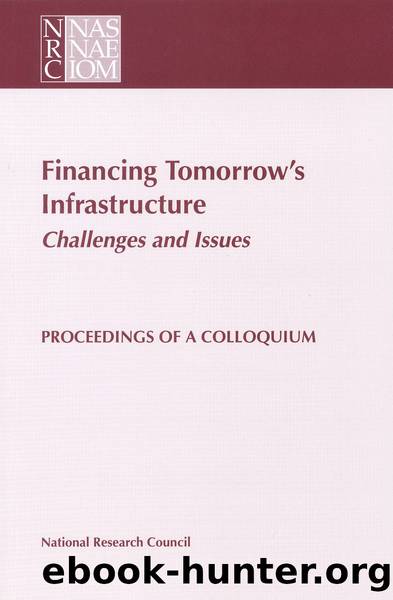FINANCING TOMORROW'S INFRASTRUCTURE: CHALLENGES AND ISSUES by Board on Infrastructure & the Constructed Environment

Author:Board on Infrastructure & the Constructed Environment
Language: eng
Format: epub
Tags: Transportation and Infrastructure
Publisher: NATIONAL ACADEMY PRESS
Published: 1996-06-05T00:00:00+00:00
Technology, Infrastructure, and Competitiveness in a National Innovation System
Deborah L. Wince-Smith
Council on Competitiveness
Although this colloquium deals with the financing of and the challenges to physical infrastructures, i.e., constructed buildings and transportation, etc., I want to give you a little broader perspective on national innovation and where this particular issue of the infrastructure falls. Also, I want to talk about how other matters that affect the ability of the United States to create national wealth and train highly skilled workers affect the infrastructure. I am going to speak rather broadly and hope that I will engender some discussion before the afternoon session.
I think we all recognize that innovation in the private sector is a requisite to national productivity and economic growth. Individual investment decisions of private enterprises ultimately affect our national economic strength. The government, as we know, has a strong interest in ensuring that business capital flows into areas that promote long-term growth, productivity, and the creation of wealth. But at the end of the day, the private sector has to translate whatever national assets we have into wealth-generating activities.
Currently, there is much discussion in the science and technology community, on the issue of government and private sector roles and responsibilities in the support of research and development (R&D) and overall competitiveness. There has been some discussion of direct fiscal incentives, such as the research and experimentation (R&E) tax credit, and much discussion of the federal investment in civilian, commercially oriented technology, or cost-shared R&D partnering. But there has not been a lot of discussion of the network of impediments, disincentives, and special interests, which, I believe, collectively stifle the ability of American firms to reap the benefits of our national leadership in science and technology and our dynamic, entrepreneurial culture.
I want to give you a framework for a national innovation system and then look at both the disincentives and potential incentives for us to capitalize on as we move into the next century. The United States, in spite of what you may hear from those who are worried about the level of government investments in R&D, spends more on R&D than France, Germany, the United Kingdom, and Japan combined. We spend a tremendous amount in the government environment on R&D, and we also spend a tremendous amount in the private sector, cumulatively between $160 billion and $170 billion. Because a robust R&D technology base is important to the economic issues I have mentioned, the federal government, at least since World War II, has been providing direct support for what we classically refer to as basic research.
Economists Michael Boskin and Lawrence Lau have estimated in a recent paper, "The Contribution of R&D to Economic Growth," that the introduction of new technology has accounted for 30 to 50 percent of economic growth. So government investment in the seed cornâthe basic research and underlying infrastructure, if you will, of knowledge creationâhas been very important.
In the last 15 years, we have seen a change in government policies, inching toward much closer interaction between
Download
This site does not store any files on its server. We only index and link to content provided by other sites. Please contact the content providers to delete copyright contents if any and email us, we'll remove relevant links or contents immediately.
Whiskies Galore by Ian Buxton(41718)
Introduction to Aircraft Design (Cambridge Aerospace Series) by John P. Fielding(33016)
Small Unmanned Fixed-wing Aircraft Design by Andrew J. Keane Andras Sobester James P. Scanlan & András Sóbester & James P. Scanlan(32684)
Aircraft Design of WWII: A Sketchbook by Lockheed Aircraft Corporation(32162)
Craft Beer for the Homebrewer by Michael Agnew(18081)
Turbulence by E. J. Noyes(7893)
The Complete Stick Figure Physics Tutorials by Allen Sarah(7264)
The Institute by Stephen King(6856)
Kaplan MCAT General Chemistry Review by Kaplan(6822)
The Thirst by Nesbo Jo(6756)
Bad Blood by John Carreyrou(6476)
Modelling of Convective Heat and Mass Transfer in Rotating Flows by Igor V. Shevchuk(6353)
Learning SQL by Alan Beaulieu(6158)
Weapons of Math Destruction by Cathy O'Neil(6084)
Man-made Catastrophes and Risk Information Concealment by Dmitry Chernov & Didier Sornette(5876)
Permanent Record by Edward Snowden(5681)
Digital Minimalism by Cal Newport;(5584)
Life 3.0: Being Human in the Age of Artificial Intelligence by Tegmark Max(5403)
iGen by Jean M. Twenge(5321)
